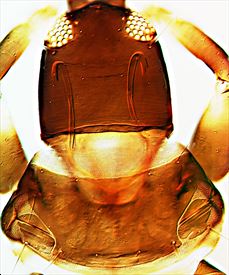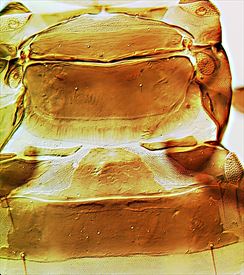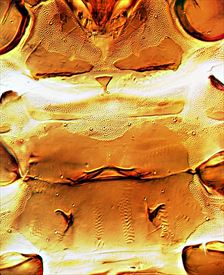Distinguishing features
Female fully winged or micropterous. Body brown, tube darkest; inner apices of femora and base and external margin of antennal segment III yellowish; major setae dark; fore wing uniformly shaded. Head nearly as wide as long; dorsal surface with faint lines of sculpture; compound eyes not large; postocular setae finely acute, wide apart, arising close to eyes; maxillary stylets wide apart, V-shaped, retracted into head as far as postocular setae. Antennae 8-segmented but VIII broadly joined to VII, the suture usually complete; segments VI and VII each with a distinct pedicel; III with 2 sense cones, IV with 4. Pronotum with faint lines of sculpture on posterior margin; basantra weakly sclerotised, ferna transverse. Mesopresternum eroded medially. Metanotum elongate, finely sculptured. Fore tarsal tooth absent. Fore wings curved in distal third, with 3 major subbasal setae and 2–8 duplicated wing cilia. Pelta faintly reticulate, with broad lateral lobes; tergite IX posteromarginal setae about half as long as tube; tube slightly constricted apically and in basal third. Microptera with ocelli reduced; metanotum broad; fore wing lobe small, round, bearing 2 small setae; pelta with short lateral lobes.
Male micropterous. Similar to female, but slightly smaller; tergite II with 1 pair of long setae laterally; large males with femora swollen and foretarsal tooth large; sternites IV–VII reticulate anterior to discal setae.
Related species
The genus Ozothrips appears to be closely related to Heptathrips and Cleistothrips, and includes five species, all known only from New Zealand. In O. eurytis there are 8 antennal segments, weak prosternal basantra are present, and the female lacks a fore tarsal tooth.
Biological data
Feeding on fungal spores on dead branches in areas of disturbed native forest, but not in areas with a closed canopy.
Distribution data
Known only from New Zealand where it is widespread (ND, AK, CL, TK / SD, NN, BR, WD, CO, SL / Chatham Is.).
Family name
PHLAEOTHRIPIDAE, IDOLOTHRIPINAE
Species name
Ozothrips eurytis Mound & Palmer
Original name and synonyms
Ozothrips eurytis Mound & Palmer, 1983: 25
References
Mound LA & Palmer JM (1983) The generic and tribal classification of spore-feeding Thysanoptera (Phlaeothripidae: Idolothripinae). Bulletin of the British Museum (Natural History). Entomology 46: 1–174.
Mound LA & Walker AK (1986) Tubulifera (Insecta: Thysanoptera). Fauna of New Zealand 10: 1–140.




